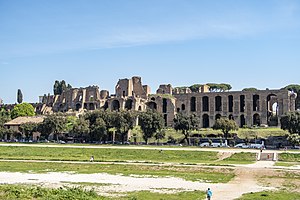
Back Palatyn Afrikaans هضبة بالاتين Arabic تل البلاتين ARZ Палацін Byelorussian Палятын BE-X-OLD Палатин Bulgarian རི་བོ་ཕ་ལ་ཏི་ཉི། Tibetan Palatin (brežuljak) BS Palatí Catalan Monte Palatino CEB
| Palatine Hill | |
|---|---|
| One of the seven hills of Rome | |
| Latin name | Palatium; Collis Palatinus |
| Italian name | Palatino |
| Rione | Campitelli |
| Buildings | Flavian Palace |
| People | Cicero, Augustus, Tiberius, Domitian |
| Events | Finding of Romulus and Remus |
| Ancient Roman religion | Temple of Apollo Palatinus, Temple of Cybele, Lupercalia, Secular Games |
| Mythological figures | Romulus and Remus, Faustulus |


The Palatine Hill (/ˈpælətaɪn/; Classical Latin: Palatium;[1] Neo-Latin: Collis/Mons Palatinus; Italian: Palatino [palaˈtiːno]), which relative to the seven hills of Rome is the centremost, is one of the most ancient parts of the city; it has been called "the first nucleus of the Roman Empire".[2] The site is now mainly a large open-air museum whilst the Palatine Museum houses many finds from the excavations here and from other ancient Italian sites.
Imperial palaces were built there, starting with Augustus. Before imperial times the hill was mostly occupied by the houses of the rich.
The hill originally had two summits separated by a depression; the highest part was called Palatium and the other Germalus (or Cermalus). Using the Forma Urbis its perimeter enclosed 63 acres (25 ha); while the Regionary Catalogues of the 4th century enclose 131 acres (53 ha).[3]
- ^ Lewis and Short, A Latin Dictionary: Palatium
- ^ Merivale, Charles, A General History of Rome: from the Foundation of the City to the Fall of Augustulus, B.C. 753— A.D. 476. New York: Harper & Brothers (1880), p. 39.
- ^ The Atlas of Ancient Rome, Biography and Portraits of the City, Ed. Andrea Carandini, Paolo Carafa, trans. Andrew Campbell Halavais, Princeton University Pressm 2012, pp. 216=17, ISBN 978-0-691-16347-5